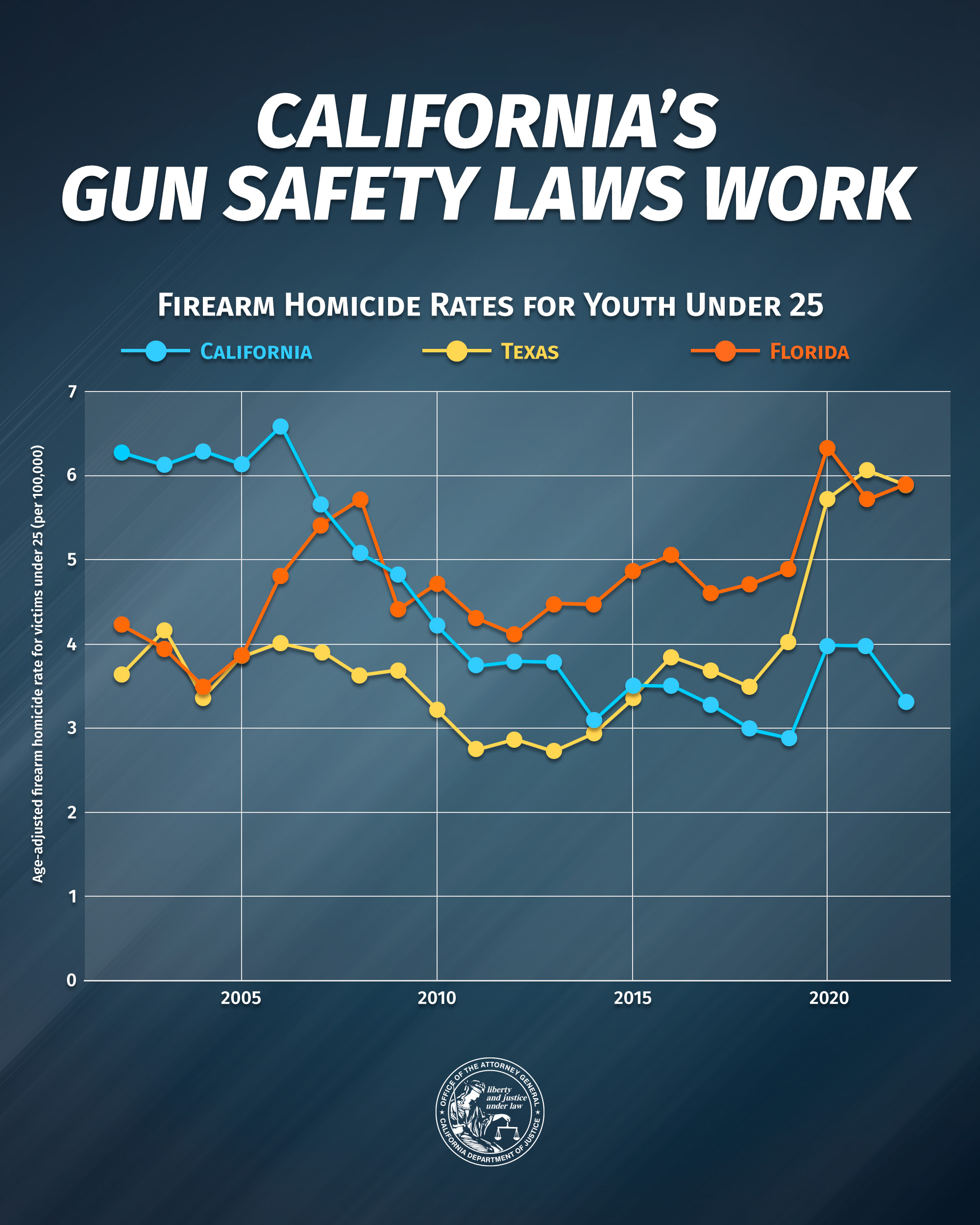
Gun Violence Data and Research
Office of Gun Violence Prevention Reports
The Impact of Gun Violence in California: In August 2023, Attorney General Bonta released the first-ever report from the Office of Gun Violence Prevention. The report provides a comprehensive review of gun violence data in California and throughout the nation to help guide policy and strategy discussions related to reducing gun violence. A copy of this report is available here.
Domestic Violence Involving Firearms: Released in November 2023, this data report provides an in-depth look at the ties between domestic violence and firearms. The report examines data illustrating the impact of firearms-related domestic violence, including both family and intimate partner-related violence with firearms. A copy of this report is available here.
Pathways to Safety: California’s Nine Court Protection Orders to Prevent Gun Violence: Released in June 2024, this report provides an in-depth look at California’s uniquely broad array of nine court protection order processes that can prevent gun violence by restricting a violent, abusive, or dangerous individual’s access to firearms. The report provides a guide to the unique features and differences between each type of protection order available in California to help stakeholders understand the full range of options available to protect survivors and the public from gun violence. The report also provides new data to document the important role each of these processes plays in preventing gun violence in our state. A copy of this report is available here.
- California's Fight Against the Ghost Gun Crisis (Oct. 2024): This report provides an in-depth look at the impact and origins of the ghost gun crisis and California’s response. It documents a dramatic increase in the number of ghost guns recovered from different types of crime from 2013-2021 and documents how California has made substantial progress against ghost guns since 2022 through a comprehensive enforcement, litigation, and legislative response. The report warns of emerging threats and shifts in the ghost gun industry and includes a California Ghost Gun Laws Reference Guide to provide a quick reference summary of new laws and policies designed to address these threats in order to promote compliance, accountability, and enforcement.
Do California’s Gun Safety Laws Work?
Yes. Although the United States is an outlier when compared to gun violence in other wealthy nations, California has one of the lowest rates 1 of firearm mortality in the country—44th out of 50. 2 Only Hawaii, Massachusetts, New Jersey, Rhode Island, New York, and Connecticut have lower firearm mortality rates. Notably, all of these states received a “B” or better on Gifford’s Law Center’s 2021 Annual Gun Law Scorecard, an assessment of the strength of each state’s gun safety laws. 3 California received an “A” for having “the strongest gun laws in the United States.”
By contrast, every state that received an “F” rating from Giffords—all 24 of them—had a higher gun death rate than California. Mississippi, Louisiana, and Wyoming, all of who received an “F,” had firearm mortality rates triple that of California.
The average firearm mortality rate in the United States is 13.7 per 100,000 people. California’s stands at 8.5 per 100,000. Texas is higher than the national average, at 14.2 per 100,000. 4
This trend is consistent across different measures of Firearm Violence. For example, Californians are about 25% less likely 5 than citizens of other states to die in a mass shooting. 6
This is no accident. In 2005, California’s firearm mortality was much more in line with other large states like Texas and Florida. Since then, California has tightened its gun laws. Florida and Texas have gone the opposite direction. 7 During that time period, California’s firearm mortality rate dropped, while the rate has increased dramatically in Florida and Texas.
Firearm Mortality Rate, Per 100,000 People
|
2005 |
2020 |
California |
9.5 |
8.5 |
Florida |
10 |
13.7 |
Texas |
11 |
14.2 |

Do Gun Violence Restraining Orders work?
- California was the first state in the nation to adopt a “red flag law,” which allows courts to issue restraining orders preventing individuals deemed to be a danger to themselves or others from possessing firearms. Generally called Gun Violence Restraining Orders or GVROs, such orders have been available in California since January 2016. In the first three years of their existence, GVROs were used in 58 cases of threatened mass shootings; in every instance for which data is available, the mass shooting did not occur. Among a study of 379 respondents in GVRO cases, only one later died as a result of a firearm injury.
While Californians are less likely to die as a result of a firearm, too many Californians still suffer the harm of gun violence:
- Someone is killed with a gun every three hours in California.
- Californians who live with handgun owners are more than twice as likely to die of homicide.
- California women living with handgun owners are more likely to die by suicide
- More than half of those killed by firearms in California die as a result of suicide
- From hiring police to detect and investigate gun crime to paying medical expenses for gun injuries, gun violence is expensive. Annually, gun violence costs the state approximately $18 billion—just under $500 per Californian.
2 The data in this section is from 2020, the most recent year for which nationwide statistics are available.
3 New Jersey and California both received an “A;” Connecticut, Hawaii, Massachusetts, and New York all scored an “A minus,” and Rhode Island received a “B.” https://giffords.org/lawcenter/resources/scorecard/
5 California Has America’s Toughest Gun Laws, and They Work, New York Times, May 31, 2022.